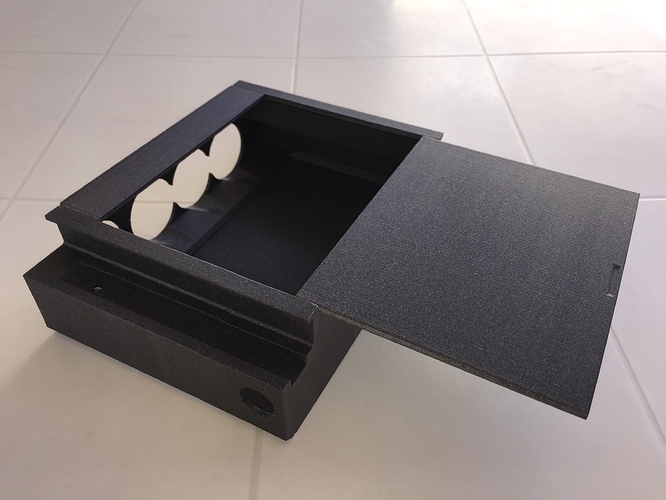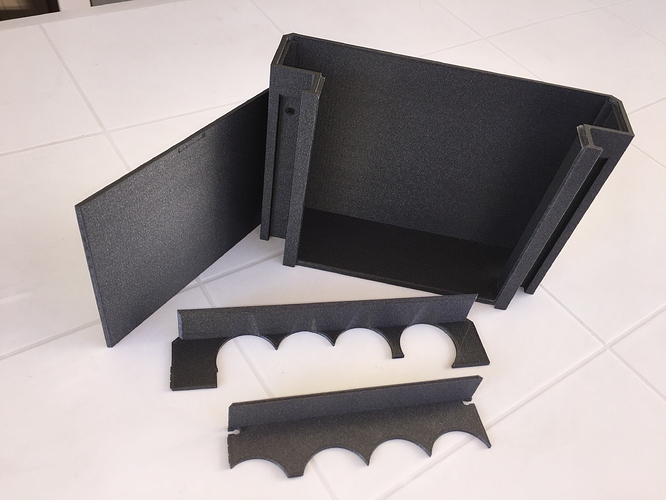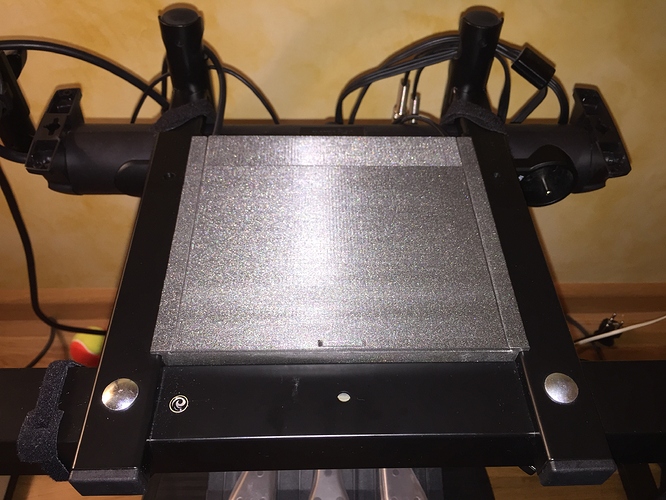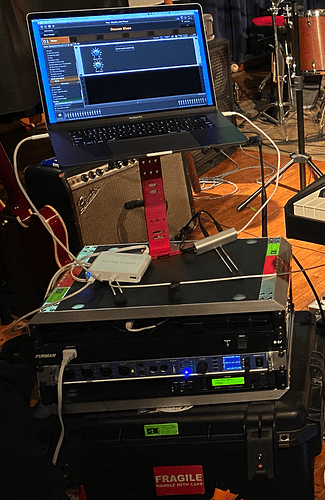Hmm, I used to use Radial DI boxes for this kind of thing
+1 for an extra box - if you can’t trust your tech to know what you have connected, you might want to protect your interface against phantom power
Good point! But yes, my existing splitter does not pass phantom power to/from FOH mixer.
Since I want to reduce my equipment to a minimum, I prefer a USB powered audio interface. Are there any recommendations?
Not an answer to your question, but for the same kind of reason, I integrated all possible power supply I have in my setup in a self made 3D printed box which is hidden under my piano keyboard and comes with my piano keyboard rig stand. It saves me a lot of time fighting with cables when moving to a venue.
And by the way, my RME UCX is also integrated to the keyboard stand and it comes with it when moving.
That is one cool integrated keystand, you got there! I really like how you’ve set things up. I guess like every key player, I also struggle with all the wires and connectors everywhere!
How do you connect all the plugs in your “amazing-power-socket-multi-connector unit”? I’m curious how you connect everything further, maybe I can borrow some of your ideas, that is, if you don’t mind sharing of course 
Humm, I start to hijack this topic ![]()
I have got 5 AC/DC adapters + some additionnal power plugs, for 3 slave power sockets and 1 master on which the PC is connected. All cables were shortened and most of the power plugs where replaced by smaller ones on which I sometimes connect more than one device. The other cables go out of the box from the side or from the back.
Ahahah I don’t mind it !
I just hope I make the best choice of audio interface in a few weeks ![]()
This is what I did, though it is temporarily a big messy due to my changing laptops and not yet having updated my system for the new connectors (hence stuff sitting on top that generally wouldn’t be there).
Basically I have a 19" rack (see image) that sits on top of its carrying case when on stage. What you can actually see in the rack are a Furman power supply, RME audio interface and MiPro wireless transmitter for my in-ears.
What you can’t see that is inside the rack are a small wifi router, an interface for my eigenharp and several powered USB hubs and miscellaneous other power supplies.
All of those things are connected to multiple rows of a patchbay on the back. That patch bay exposes multiple USB connectors (into which I plug the keyboards and control surfaces and iPads), a collection of XLR sockets (8 outs going to FOH and 2 ins for the band mix into my in-ear system), various other power sources for devices that need their own power (including my old laptop, which I now have to change the connector) and a single A/C input for power.
Hence everything in my environment just gets plugged into the back of that rack and there’s one cable that goes to the stage for power.
It’s a bit heavy but it really impacts setup and teardown time because it’s essentially (and almost literally) plug and play!
One day, when I am grown up, I will own the same audio interface than yours… 
… And GP panels as sophisticated as this one ![]()
What do you want, this is the Sunday panel with two knobs of identical size and perfectly aligned! 
I had a few 12v items in my rack so I bought a 12v power supply with screw terminal connection and enough amps to handle multiple devices. Saved weight and space.
Be aware of heat. I have a similar config and my rme ufx once crashed completely. After the repair i recognized that the RME UFX really get hot. Put some fans in your rack for cooling down the devices…
I just hope I make the best choice of audio interface in a few weeks
I want to use a good audio interface for two things :
1- playing gigs with Gig Performer and plenty of vsts.
2- record some of my acoustic piano and maybe add effects on acoustic piano in live.
Just reiterating a couple prior points…
For 1) I think just about any audio interface will do fine for playing plenty of VSTs. VST performance is entirely in the PC, all the audio interface is going to do is digital to analog conversion.
For 2) you need mic inputs. Just figure out how many you need. Nobody in any audience is going to hear a difference between the mic pre’s on a $300 interface vs. a $3,000 interface. Something as cheap as a $220 MOTU M4 will handle what you’re describing just fine, and you could kick it down the road show to show and I’m pretty sure it would hold up.
I love my RME UFX II, but in a blind listening test there’s just no way I’d hear any difference between that and my MOTU M4 or Focusrite 18i20. I just use them all in different places where I need different IO capabilities (or form factor for the M4).
Are you very sure about this? Did you do some kind of double blind test playing an high end piano VST? I did and I am not the kind of guy who notices some sound differences between cold and hot scrambled water. ![]() I even did double blind test with member of my familly who could easily find differences. Of course, if you don’t compare, you will probably be happy, as I think none of the modern audio interfaces sound bad.
I even did double blind test with member of my familly who could easily find differences. Of course, if you don’t compare, you will probably be happy, as I think none of the modern audio interfaces sound bad.
I’m curious, how would a piano VST be affected by your audio interface, if it’s only being sent a MIDI signal? It’s the preamps, connectivity, DSP power, and latency that vary between the lower end devices and the higher end ones. Assuming that audible latency isn’t a factor in the blind test, how would anything be different?
The audio output from the piano VST (any VST) goes to the audio interface.
I used to use the MOTU 828 and the difference after switching to the RME UFX was night and day.
I didn’t want to promote RME, I just wanted to tell they are differences between audio interfaces especially on a piano (even if at the end I bought an UCX because it was the one that sounded better for me). I didn’t do tests on MIC preamps.
Technically, what is different?
Audibly, what is different?
Can you hear a difference through a stage monitor?
I’ve watched this video a few times over the last year and to me the differences are in color of sound, which is easily adjusted for with a good eq. Just my opinion…




